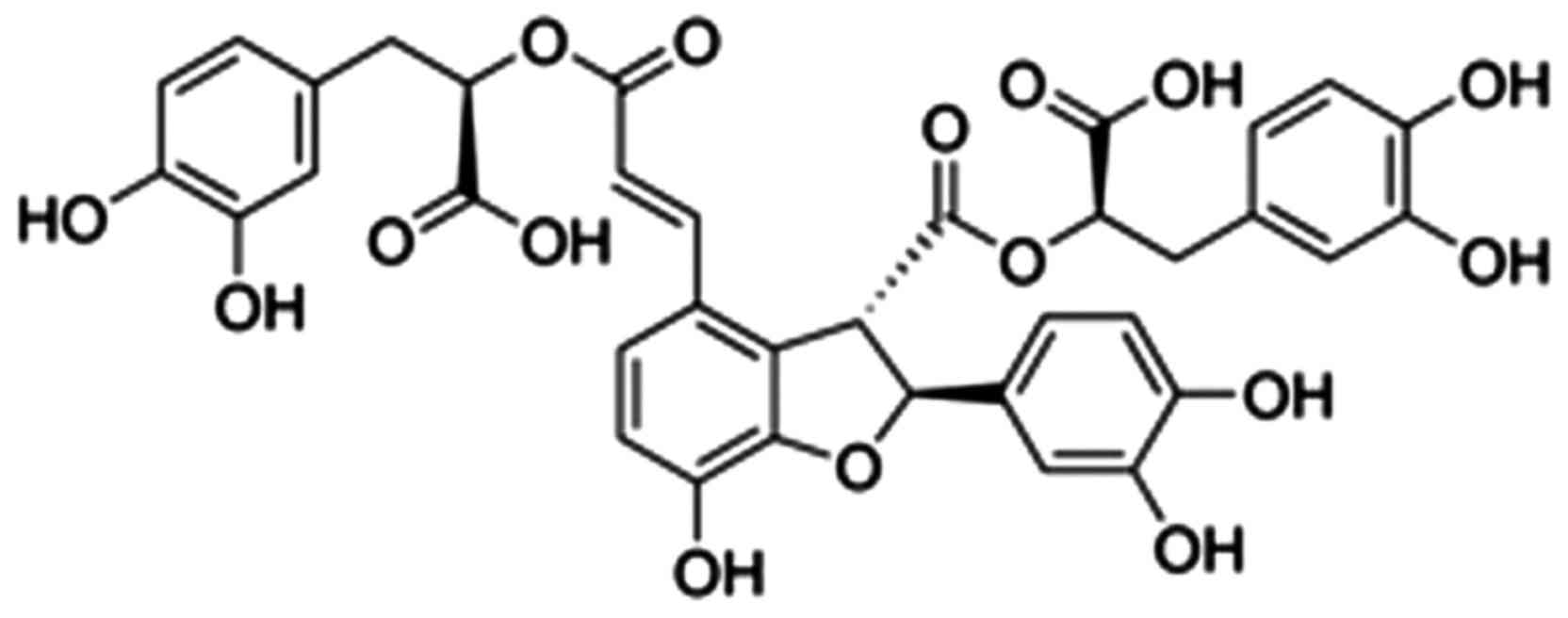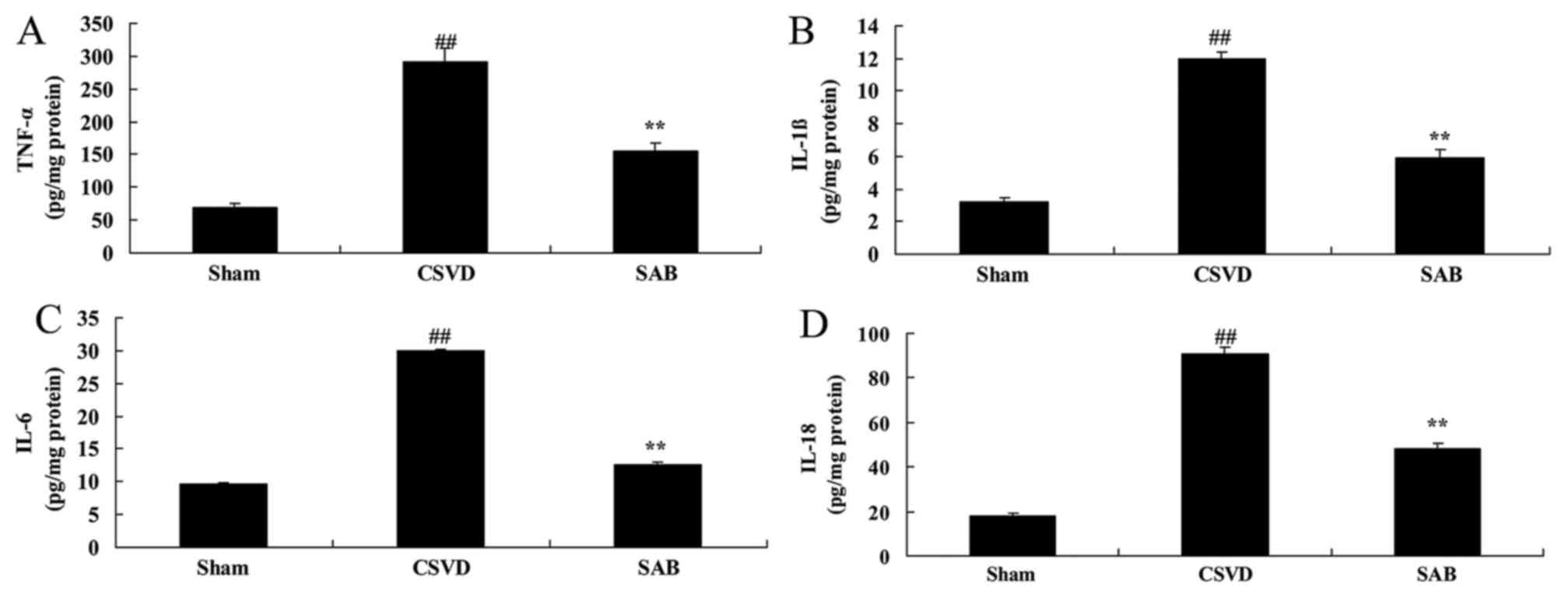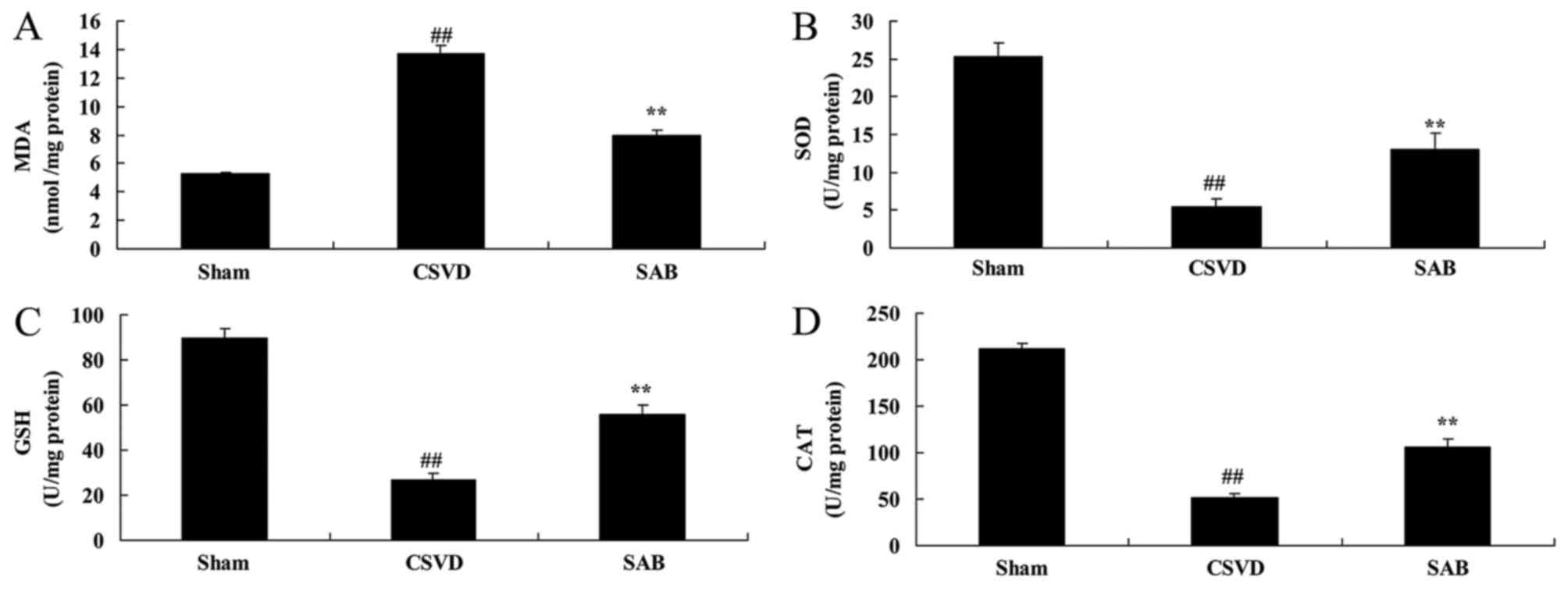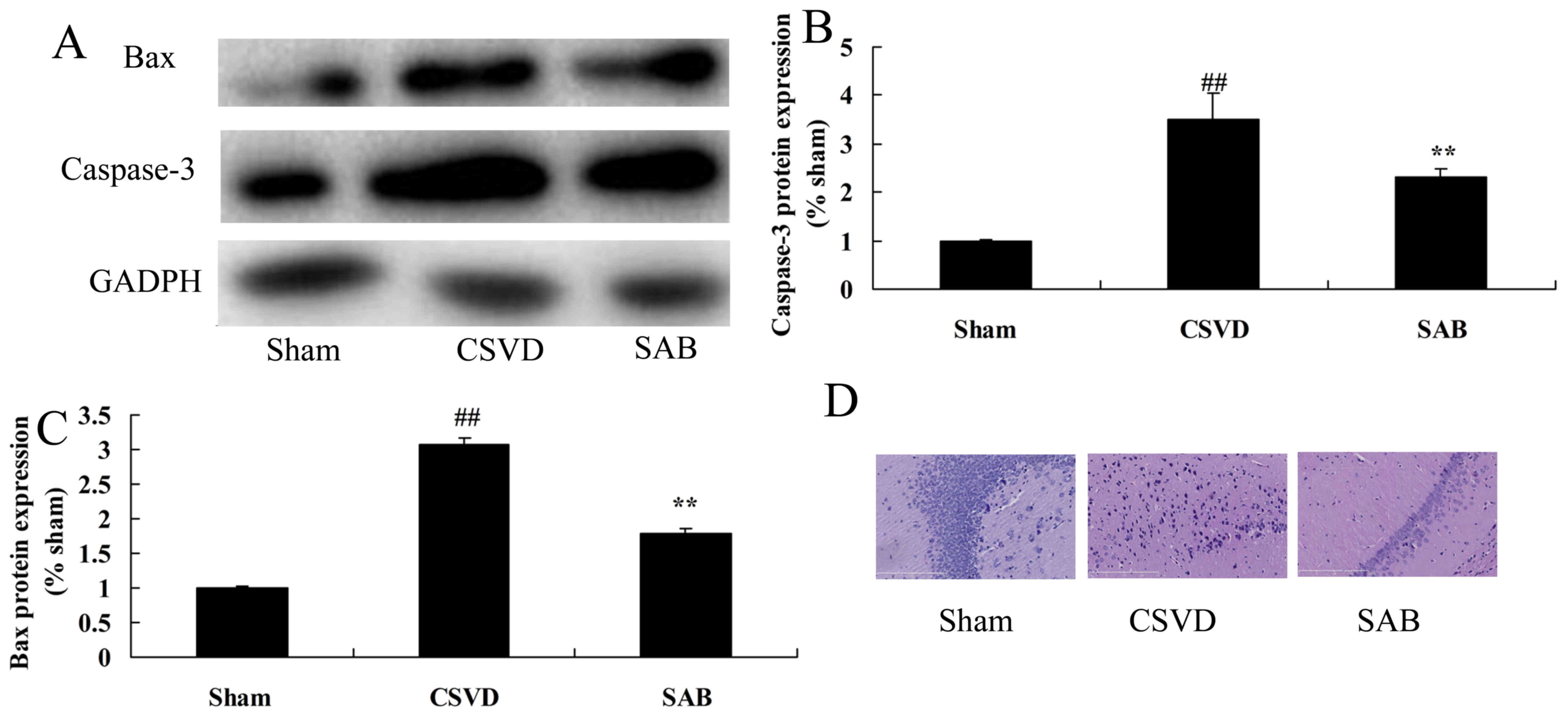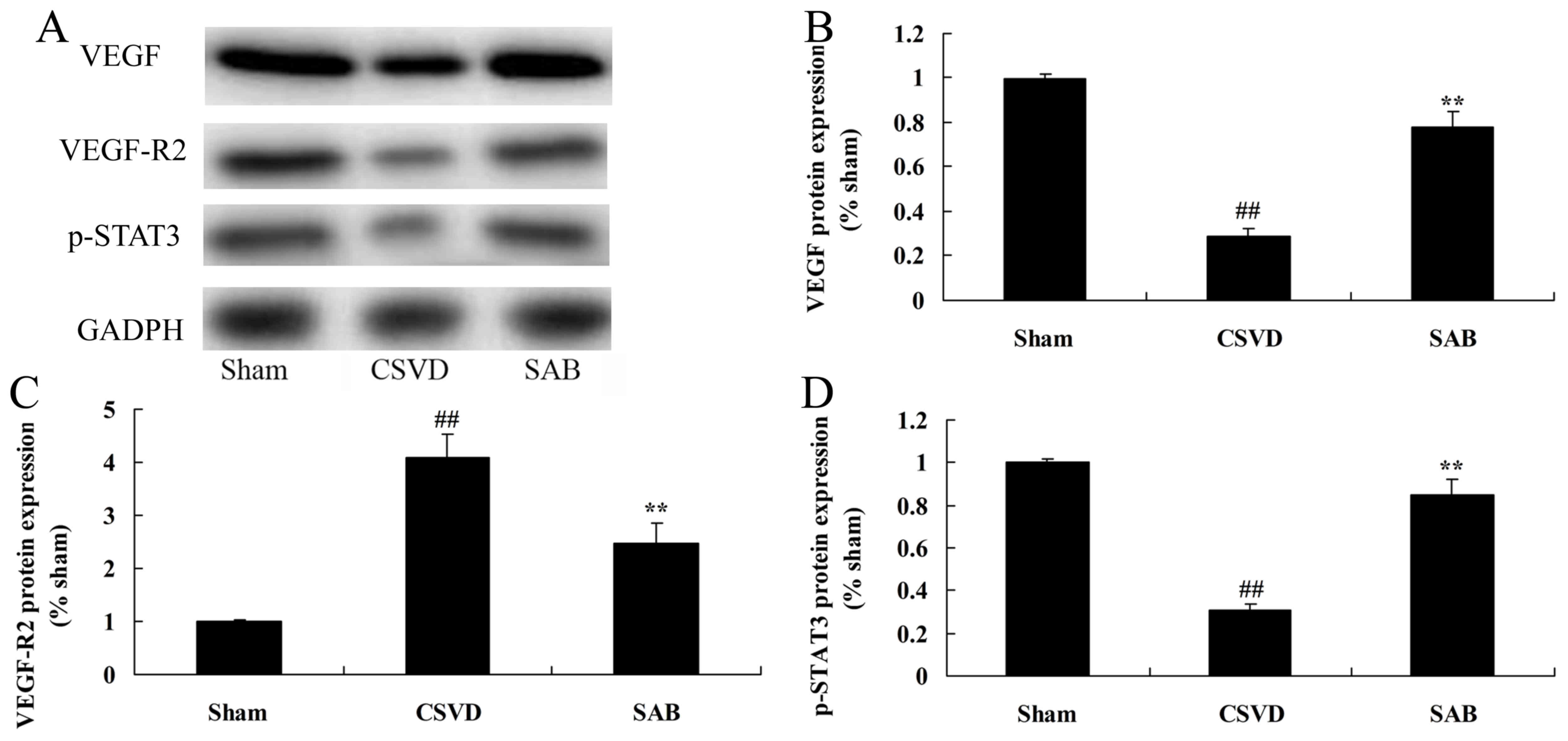Salvianolic acid B recovers cognitive deficits and angiogenesis in a cerebral small vessel disease rat model via the STAT3/VEGF signaling pathway
- Authors:
- Published online on: December 6, 2017 https://doi.org/10.3892/mmr.2017.8203
- Pages: 3146-3151
Abstract
Introduction
Cerebral small vessel disease (CSVD) is an important type of cerebrovascular diseases, which is the primary cause of aged cognitive impairment and loss of function, and is closely associated with the pathophysiology of apoplexy, dementia and aging (1). In western countries, CSVD is accountable for ~25% of the causes of ischemic strokes (1), and an additional study in China indicated that 46% of strokes are due to lacunar infarct (2). In 2012, small vessel disease was discussed at the International Apoplexy Conference and European Apoplexy Conference (3), and CSVD has gained attention from clinicians in departments of neurology and imaging (4).
CSVD is comprised of lacunar infarction, leukodystrophy and cerebral hemorrhage, and it is recognized that CSVD is a vascular wall lesion caused by increasing age, hypertension and vascular amyloidosis (5). It has been identified that there are no concomitant clinical symptoms and signs with cerebral microbleeds (5), while tissue damage of corresponding parts caused by the increasing of cerebral microbleeds may induce cognitive impairment (4). It has been identified that the majority of patients with cerebral microbleeds present with a low score on information processing speed and executive capacity, particularly for those patients whose cerebral microbleeds were present in the deep brain and region below the tentorium of the cerebellum. In addition, it is dependent on the scale of white matter lesion and ischemic brain death, which suggests that cerebral microbleeds caused cognitive impairment (6).
Gap expansions around the blood vessel have been associated with lacunar infarction and leukodystrophy (7). Previous studies have indicated that the age, hypertension, volume of leukodystrophy, lacunar infarction and the gap expansion surrounding the blood vessel should be regarded as the MRI indicator of advanced CSVD (7,8). A previous study indicated that progressive CSVD is associated with decreasing cognitive impairment, particularly with non-verbal inference and visual-spatial ability (9). This is possibly due to the enlarged gaps around blood vessel breaking the nerve fibers of basal ganglia region and central semiovale center which are associated with cognitive functions (10).
Vascular endothelial growth factor (VEGF) is present in the central nervous system and was the first identified mature cellular growth factor (10). In addition to stimulating the proliferation of endothelial cells, it is able to inhibit cell apoptosis and maintain survival of nerve cells (11). The signal transducer and activator of transcription (STAT) family is a group of transcription factor proteins including STAT1, STAT2, STAT3, STAT4, STAT5 and STAT6. During the development process of the central nervous system, STAT proteins are present in the neurons and neurogliocytes. As important members of the STAT family, the expression of STAT3 is markedly increased following cerebral ischemic injury and the activity also increases when stimulated by cytokines and growth factors (12). Following initiation of CSVD, the injured brain tissue releases reactive oxygen species (ROS), cytokines and chemokines, which can activate STAT3 through common receptor glycoprotein 130 and the STAT3 signaling pathway undergoes phosphorylation under stimulation by ROS, cytokines and chemokines (13).
The present study indicated that salvianolic acids were the most water-soluble in Salvia miltiorrhiza Bunge (14). Salvianolic acid B (Fig. 1) is the active ingredient with the strongest biological activity in salvianolic acid (15). A previous study has identified that salvianolic acid can be used to protect against myocardial ischemia/reperfusion injury, myocardial infarction and cardiomyocyte hypertrophy (16). It was suggested that in the early period of induction of newborn rat myocaridial cell injury with lipopolysaccharides, the toll-like receptor 4-nuclear factor κB-tumor necrosis factor (TNF)-α pathway is rapidly activated and salvianolic acid B takes effect to protect against myocardial cell injury, which is possibly mediated by inhibition of this pathway (15,16).
Materials and methods
Animals
Male Sprague-Dawley rats (weight, 210–230 g; 8 weeks, n=6) and spontaneously hypertensive rats (SHR; n=20) were purchased from Beijing Vital River Laboratory Animal Technology Co., Ltd. (Beijing, China), and were maintained at a constant temperature (23–24°C), humidity (50–55%) with a 12 h light/dark cycle with free access to food and water. Male Sprague-Dawley rats were assigned to sham (control) group (n=6), SHR were randomly assigned to two groups: CSVD model group (n=10) and salvianolic acid B treatment group (n=10). In the salvianolic acid B treatment group, rats were treated with 80 mg/kg of salvianolic acid B (Sigma-Aldrich; Merck KGaA, Darmstadt, Germany) for 8 weeks. The experiments of the current study were approved by the Medical Ethics Committee of Beijing Chaoyang Hospital, Capital Medical University (Beijing, China).
Behavioral tests
A circular pool (180×42 cm) was filled with water (22±2°C) to a height of 35 cm. Briefly, rats were placed in the arena and on the platform for 10 min on four consecutive days. The pool was divided into quadrants and indicated by optical cues. A transparent escape platform was placed at beneath the water surface (2 cm) in the center of one quadrant. Rats were placed at a rotarod drum and time (sec) of latency to fall from the rod, which was measured three times per day was measured. Average latency was calculated for each testing day.
Enzyme-linked immunosorbent assay
Peripheral blood was extracted from each rat and serum was obtained subsequent to centrifugation at 2,000 × g for 10 min at 4°C. Serum was used to measure inflammation [TNF-α (H052), interleukin (IL)-1β (H002), IL-6 (H007) and IL-18 (H015)] and oxidative stress [superoxide dismutase (SOD, A001-1-1), catalase (CAT, A007-1-1), glutathione (GSH, A006-2) and malondialydehyde (MDA, A003-1)] using ELISA kits (Nanjing Jiancheng Bioengineering Institute, Nanjing, China).
Western blot analysis
Tissue samples were homogenized by adding lysis buffer and a protease inhibitor and the supernatant was collected following centrifugation at 13,800 × g for 10 min at 4°C. Total protein concentration was determined using a bicinchoninic acid protein assay (Beyotime Institute of Biotechnology, Nanjing, China). The protein sample was separated by 6–10% SDS-PAGE and transferred onto a polyvinylidenedifluoride membrane (Bio-Rad Laboratories, Inc., Hercules, CA, USA). Membrane was blocked with 5% nonfat milk in Tris-buffered saline with 0.1% Tween 20 (TBS-T) for 1 h at room temperature and were incubated with the following primary antibodies: Caspase-3 (sc-98785, 1:1,000), Bcl-2-associated X protein (Bax; sc-6236, 1:1,000), VEGF (sc-13083, 1:1,000), VEGF-R2 (sc-504, 1:1,000), phosphorylated STAT3 (p-STAT3; sc-8001-R, 1:1,000) and GAPDH (sc-25778, 1:1,000, Santa Cruz Biotechnology, Inc., Dallas, TX, USA) overnight at 4°C. The membranes were washed three times for 10 min in TBS-T and further incubated for 1 h at 37°C with horseradish peroxidase (HRP)-conjugated goat anti-rabbit Immunoglobulin G (sc-2030, 1:5,000, Santa Cruz Biotechnology, Inc.) and observed using the enhanced chemiluminescent HRP substrate (WBKLS0500; EMD Millipore, Billerica, MA, USA).
Statistical analysis
Experiments were repeated in triplicate; data are presented as the mean ± standard error. Comparisons between mutants were made using one-way analysis of variance, with a Bonferonni post hoc test. P<0.05 was considered to indicate a statistically significant difference.
Results
Salvianolic acid B recovers cognitive deficits in CSVD rat
Cognitive deficits were evaluated in CSVD rats with salvianolic acid B, which exhibited that salvianolic acid B has nervous effects in CSVD. As presented in Fig. 2A and B, escape latency and mean path length of CSVD rats were significantly reduced compared with those of the sham group. However, time spent in the target quadrant and the number of times the animals crossed the former platform location of CSVD rats were significantly increased compared with the sham group (Fig. 2C and D). Following treatment with salvianolic acid B, cognitive deficits were recovered, escape latency was reduced and mean path length was reduced. The rats spent less time in the target quadrant and the number of times the animals crossed the former platform location was reduced in CSVD rats by salvianolic acid B, when compared with CSVD model rats (Fig. 2).
Salvianolic acid B reduces inflammation in CSVD rats
In the sham group, reduction of TNF-α, IL-1β, IL-6 and IL-18 levels was observed, compared with CSVD model group (Fig. 3). Treatment with salvianolic acid B significantly reduced TNF-α, IL-1β, IL-6 and IL-18 levels compared with the CSVD model rats (Fig. 3).
Salvianolic acid B reduces oxidative stress in CSVD rat
By contrast, significantly higher levels of MDA, and reduced levels of SOD, CAT and GSH in CSVD model group, compared with the sham rats (Fig. 4). The administration of salvianolic acid B significantly inhibited MDA and increased SOD, CAT and GSH levels in CSVD rats, compared with the CSVD model rats (Fig. 4).
Salvianolic acid B reduces neurocyte apoptosis (caspase-3 and Bax protein expression) in CSVD rats
To confirm the anti-apoptotic effects of salvianolic acid B in CSVD, caspase-3 and Bax protein expression was measured by western blot analysis. As presented in Fig. 5A-C, caspase-3 and Bax protein expression of the CSVD model group were higher than those of the sham group. Salvianolic acid B significantly reduced caspase-3 and Bax protein expression of CSVD rat, compared with the CSVD model group (Fig. 5A-C). A significantly greater number of nerve cells was observed in the sham group compared with the CSVD model group (Fig. 5D). Treatment with salvianolic acid B significantly promoted the number of nerve cells in CSVD rats, compared with the CSVD model group (Fig. 5D).
Salvianolic acid B recovers STAT3 phosphorylation, VEGF and VEGF-R2 protein expression in CSVD rats
In order to analyze the mechanism underlying the effects of salvianolic acid B on CSVD, STAT3 phosphorylation, VEGF and VEGF-R2 protein expression in CSVD rats, western blot analysis was conducted. p-STAT3, VEGF and VEGF-R2 protein expression levels in CSVD rats were lower than those of the sham group (Fig. 6). Treatment with salvianolic acid B significantly upregulated p-STAT3 protein expression, and induced VEGF and VEGF-R2 protein expression in CSVD rat, compared with the CSVD model group (Fig. 6).
Discussion
With the aging population in China, CSVD is a cause of economical burden to society due to the high morbidity, recurrence rate, disability rate and fatality rate (17), and CSVD-associated morbidity is increasing in China (4). It is accepted that CSVD is closely associated with numerous diseases including apoplexy, cognitive and affective impairment and instability of gait and function aging (18). In the present study, salvianolic acid B was identified to recovers cognitive deficits in CSVD rats.
The mechanism by which CSVD causes damage to the brain is complex remains to be fully understood (19). Congenital and acquired risk factors cause microvascular disease, and this leads to a series of pathological changes, reduction of cerebral blood flow, oligodendrocyte apoptosis and the destruction and inflammation of the blood brain barrier (6). These observations suggest that salvianolic acid B recovers neurocytes, reduces inflammation, oxidative stress and neurocyte apoptosis in CSVD rats. Lv et al (20) demonstrated that salvianolic acid B attenuated apoptosis and inflammation via sirtuin 1 activation in stroke rats.
Subsequent to CSVD in adult rats, the expression of p-STAT3 in brain tissue increases and the location of p-STAT3 in nerve cells varies (21). Certain studies reported that p-STAT3 is predominantly expressed in nerve cells and that p-STAT3 is expressed in reactive astrocyte cells and gitter cells (21,22). In addition the excitation effect of STAT3 for ischemic brain injury remains controversial (22). A previous study suggested that the excitation effect of STAT3 can increase the inhibitor of apoptotic protein Bcl-2 and Bcl-xl and decrease the Bax expression of apoptotic protein Bax to take the excitation effect of nerves (22). An additional study reported that excessive activation of STAT3 can cause nerve cell apoptosis (23). The current study demonstrated that salvianolic acid B significantly upregulated p-STAT3 protein expression in CSVD rat. Liu et al (14) reported that salvianolic acid B increased proliferation rate by activating Janus kinase 2-STAT3 pathways in stem cells.
VEGFs are important downstream effector molecules for STAT3. VEGF can promote the generation of new blood vessels and vascular remodeling, and is also an important neurotrophic and protective factor (24). The protective effect on the central nervous system has been a focus of research (11). A previous study indicated that VEGF increased following CSVD in rats, the changing trend of expression for VEGF was opposite to that of the trend for apoptosis (11). This indicates that when VEGF expression is high, the apoptosis levels are low (25). By contrast, when VEGF decreases, the apoptosis will increase, which may be due to the gradual reduction of p-STAT3 protein, the regulated VEGF expression will decrease and the protein which has protective effect to nerves will also decrease. Therefore this will cause the exacerbation of injury and increase of apoptosis cells. In the present study, it was identified that salvianolic acid B significantly upregulated VEGF and VEGF-R2 protein expression in CSVD rats.
In conclusion, the present study was, to the best of our knowledge, the first to demonstrate that salvianolic acid B recovers cognitive deficits and neurocytes, reduced inflammation, oxidative stress and neurocyte apoptosis in CSVD rats through the STAT3/VEGF signaling pathway. These results provide a potential novel therapeutic strategy for the treatment of CSVD.
References
|
Kwon HM, Lynn MJ, Turan TN, Derdeyn CP, Fiorella D, Lane BF, Montgomery J, Janis LS, Rumboldt Z and Chimowitz MI; SAMMPRIS Investigators, : Frequency, risk factors, and outcome of coexistent small vessel disease and intracranial arterial stenosis: Results from the stenting and aggressive medical management for preventing recurrent stroke in intracranial stenosis (SAMMPRIS) Trial. JAMA Neurol. 73:36–42. 2016. View Article : Google Scholar : PubMed/NCBI | |
|
Mi T, Yu F, Ji X, Sun Y and Qu D: The interventional effect of remote ischemic preconditioning on cerebral small vessel disease: A pilot randomized clinical trial. Eur Neurol. 76:28–34. 2016. View Article : Google Scholar : PubMed/NCBI | |
|
Papma JM, de Groot M, de Koning I, Mattace-Raso FU, van der Lugt A, Vernooij MW, Niessen WJ, van Swieten JC, Koudstaal PJ, Prins ND and Smits M: Cerebral small vessel disease affects white matter microstructure in mild cognitive impairment. Hum Brain Mapp. 35:2836–2851. 2014. View Article : Google Scholar : PubMed/NCBI | |
|
Pavlovic AM, Pekmezovic T, Tomic G, Trajkovic JZ and Sternic N: Baseline predictors of cognitive decline in patients with cerebral small vessel disease. J Alzheimers Dis. 42 Suppl 3:S37–S43. 2014.PubMed/NCBI | |
|
Benjamin P, Lawrence AJ, Lambert C, Patel B, Chung AW, MacKinnon AD, Morris RG, Barrick TR and Markus HS: Strategic lacunes and their relationship to cognitive impairment in cerebral small vessel disease. Neuroimage Clin. 4:828–837. 2014. View Article : Google Scholar : PubMed/NCBI | |
|
Dearborn JL, Schneider AL, Sharrett AR, Mosley TH, Bezerra DC, Knopman DS, Selvin E, Jack CR, Coker LH, Alonso A, et al: Obesity, insulin resistance, and incident small vessel disease on magnetic resonance imaging: Atherosclerosis risk in communities study. Stroke. 46:3131–3136. 2015. View Article : Google Scholar : PubMed/NCBI | |
|
Bridges LR, Andoh J, Lawrence AJ, Khoong CHL, Poon W, Esiri MM, Markus HS and Hainsworth AH: Blood-brain barrier dysfunction and cerebral small vessel disease (arteriolosclerosis) in brains of older people. J Neuropathol Exp Neurol. 73:1026–1033. 2014. View Article : Google Scholar : PubMed/NCBI | |
|
Shi Y, Thrippleton MJ, Makin SD, Marshall I, Geerlings MI, de Craen AJ, van Buchem MA and Wardlaw JM: Cerebral blood flow in small vessel disease: A systematic review and meta-analysis. J Cereb Blood Flow Metab. 36:1653–1667. 2016. View Article : Google Scholar : PubMed/NCBI | |
|
Teng Z, Dong Y, Zhang D, An J and Lv P: Cerebral small vessel disease and post-stroke cognitive impairment. Int J Neurosci. 127:824–830. 2017. View Article : Google Scholar : PubMed/NCBI | |
|
Platt SR: Angiogenesis and cerebral neoplasia. Vet Comp Oncol. 3:123–138. 2005. View Article : Google Scholar : PubMed/NCBI | |
|
Zampetti A, Gnarra M, Borsini W, Giurdanella F, Antuzzi D, Piras A, Smaldone C, Pieroni M, Cadeddu C, de Waure C and Feliciani C: Vascular endothelial growth factor (VEGF-a) in Fabry disease: Association with cutaneous and systemic manifestations with vascular involvement. Cytokine. 61:933–939. 2013. View Article : Google Scholar : PubMed/NCBI | |
|
Kim HC, Kim E, Bae JI, Lee KH, Jeon YT, Hwang JW, Lim YJ, Min SW and Park HP: Sevoflurane postconditioning reduces apoptosis by activating the JAK-STAT pathway after transient global cerebral ischemia in rats. J Neurosurg Anesthesiol. 29:37–45. 2017. View Article : Google Scholar : PubMed/NCBI | |
|
Hou YC, Liou KT, Chern CM, Wang YH, Liao JF, Chang S, Chou YH and Shen YC: Preventive effect of silymarin in cerebral ischemia-reperfusion-induced brain injury in rats possibly through impairing NF-κB and STAT-1 activation. Phytomedicine. 17:963–973. 2010. View Article : Google Scholar : PubMed/NCBI | |
|
Liu CH, Shyu WC, Fu RH, Huang SJ, Chang CH, Huang YC, Chen SY, Lin SZ and Liu SP: Salvianolic acid B maintained stem cell pluripotency and increased proliferation rate by activating Jak2-Stat3 combined with EGFR-Erk1/2 pathways. Cell Transplant. 23:657–668. 2014. View Article : Google Scholar : PubMed/NCBI | |
|
Li L, Xu T, Du Y, Pan D, Wu W, Zhu H, Zhang Y and Li D: Salvianolic acid a attenuates cell apoptosis, oxidative stress, Akt and NF-κB activation in angiotensin-II induced murine peritoneal macrophages. Curr Pharm Biotechnol. 17:283–290. 2016. View Article : Google Scholar : PubMed/NCBI | |
|
Xue L, Wu Z, Ji XP, Gao XQ and Guo YH: Effect and mechanism of salvianolic acid B on the myocardial ischemia-reperfusion injury in rats. Asian Pac J Trop Med. 7:280–284. 2014. View Article : Google Scholar : PubMed/NCBI | |
|
Noh SM, Kim BJ and Kim JS: Cerebral small vessel disease may be related to antiplatelet-induced gastrointestinal bleeding. Int J Stroke. 9:E382014. View Article : Google Scholar : PubMed/NCBI | |
|
Arba F, Quinn T, Hankey GJ, Ali M, Lees KR and Inzitari D; VISTA Collaboration, : Cerebral small vessel disease, medial temporal lobe atrophy and cognitive status in patients with ischaemic stroke and transient ischaemic attack. Eur J Neurol. 24:276–282. 2017. View Article : Google Scholar : PubMed/NCBI | |
|
Yang S, Cai J, Lu R, Wu J, Zhang M and Zhou X: Association between serum cystatin C level and total magnetic resonance imaging burden of cerebral small vessel disease in patients with acute lacunar stroke. J Stroke Cerebrovasc Dis. 26:186–191. 2017. View Article : Google Scholar : PubMed/NCBI | |
|
Lv H, Wang L, Shen J, Hao S, Ming A, Wang X, Su F and Zhang Z: Salvianolic acid B attenuates apoptosis and inflammation via SIRT1 activation in experimental stroke rats. Brain Res Bull. 115:30–36. 2015. View Article : Google Scholar : PubMed/NCBI | |
|
Stechishin OD, Luchman HA, Ruan Y, Blough MD, Nguyen SA, Kelly JJ, Cairncross JG and Weiss S: On-target JAK2/STAT3 inhibition slows disease progression in orthotopic xenografts of human glioblastoma brain tumor stem cells. Neuro Oncol. 15:198–207. 2013. View Article : Google Scholar : PubMed/NCBI | |
|
D'Angelo B, Ek CJ, Sun Y, Zhu C, Sandberg M and Mallard C: GSK3β inhibition protects the immature brain from hypoxic-ischaemic insult via reduced STAT3 signalling. Neuropharmacology. 101:13–23. 2016. View Article : Google Scholar : PubMed/NCBI | |
|
Ma X, Zhou Y, Chai Y, Wang X and Huang X: Stat3 controls maturation and terminal differentiation in mouse hippocampal neurons. J Mol Neurosci. 61:88–95. 2017. View Article : Google Scholar : PubMed/NCBI | |
|
Ahmed-Jushuf F, Jiwa NS, Arwani AS, Foot P, Bridges LR, Kalaria RN, Esiri MM and Hainsworth AH: Age-dependent expression of VEGFR2 in deep brain arteries in small vessel disease, CADASIL, and healthy brains. Neurobiol Aging. 42:110–115. 2016. View Article : Google Scholar : PubMed/NCBI | |
|
Lee SC, Lee KY, Kim YJ, Kim SH, Koh SH and Lee YJ: Serum VEGF levels in acute ischaemic strokes are correlated with long-term prognosis. Eur J Neurol. 17:45–51. 2010. View Article : Google Scholar : PubMed/NCBI |



